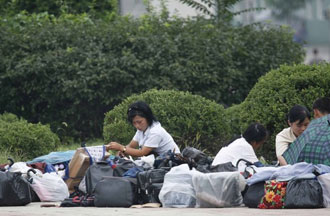While the U.S. and S. Korea have been agonizing over how to handle the oppressive, nuclear-armed Kim Jong-il regime, the North Korean people have begun liberating themselves through a black-market economy that is likely soon to eclipse the official centrally controlled economy.
Last year when N. Korea sank the S. Korean navy ship Cheonan and shelled Cheongpyeong Island, it seemed the only way for the South to rid itself of the constant threat of war and to liberate fellow Koreans in the North from unspeakable suffering was to bring down the Kim regime through military action – with the attendant risk of having Seoul devastated by the fury of some 11,000 artillery pieces and even a possible nuclear strike.
That may not be necessary after all.
The South had been giving the North about a half million tons of food aid and 300,000 tons of fertilizer aid each year. In the wake of the North’s attacks, S. Korean President Lee Myung-bak cut off that aid. He also banned the imports of sand and seafood which had been providing the Kim regime another $90 mil. a year in foreign exchange.
Much of the aid from the South had been used by the Kim regime to dole out food rations to the North’s population. But since the sanctions, N. Korea has been able to provide rations only to its 1.4-million man army and about 2.6 mil. party cadres who mostly live in Pyongyang, according to S. Korean intelligence. That left about 20 million N. Koreans to find other ways to feed themselves. Recently surfaced accounts of the desperate struggles among the starving include limbs of children being cooked in pots for food.
The only place to which the N. Korean masses could turn for additional food and other essential goods were the black markets. Initially started mostly by housewives trying to make ends meet, they have been in existence since around 2000 but only mushroomed in 2009 after the North’s botched currency reform wrecked any semblance of a functioning official economy. The recent cutting off of S. Korean aid and trade has given this underground free-market system the quasi-legitimacy of desperation. A system that’s keeping a majority of the population from starving to death is a necessary evil in the eyes of even a regime as callous and repressive as Kim’s. Official measures to suppress it has become half-hearted, even timid, especially after several recent protests ended in killings of local officials trying to enforce restrictive regulations.
At the moment over 300 black markets are known to be thriving. Even the capital city of Pyongyang has been supporting some large black markets since 2003. The Tongilgori Market in the city’s Rakrang District is housed in three buildings and a parking lot. The Jungang Market in the Jung District is contained within a large domed structure with a parking area.
Much of the goods for these and other black markets come from the Chaeha Market in Sinuiju near the Chinese border in the far northeast, the leading outlet for goods imported from China. Another major source of imported goods is the Hoeryong Market in Hoeryong, North Hamgyong Province which was originally established to give the Kim regime a source of foreign exchange and control over the inflow of goods.
But in recent years the level of black market activity has boomed to levels far in excess of what the Kim regime had expected. Rather than being a mere safety valve to allow people a way to make up for domestic food shortfalls, they have become economic mainstays for much of the population. Equally worrisome to the Kim regime is that these markets aren’t only a source of food and other goods but are also places where information from the outside world is propagated.
Sporadic attempts at cracking down on such markets has been tempered by the fear of inciting the kind of mass violence that greeted the failed currency reforms. These markets are breaking down the degree of control the Kim regime has been able to exercise in the past. As the centrally-controlled distribution mechanisms become less relevant to the average N. Korean, the black markets are becoming an alternative economic system over which the regime can assert little control without risking an open uprising. The proliferation of black market activity has even created a new class of wealthy entrepreneurs who have the resources to bribe officials and further undermine the central government control.
North Korea is now in serious danger of becoming a free market economy with a vestigial communist regime seeking vainly for a means to reassert its authority. The only way the Kim regime can become relevant again is to restart the flow of external aid and trade over which it can exert a higher degree of control.
South Korea has taken note of this trend and is actively seeking to stimulate further “internal energy” for regime change in the North by keeping its hard line against renewing aid and trade in the absence of clear signs of a radically less militaristic focus.
Whether Kim Jong-il regime decides to hold fast to its current oppressive scheme backed up by a nuclear arsenal or to accommodate itself to more normal commerce with the outside world, the result would appear to be the same in the long run — a nation on track to be liberated from 60 years of slow asphyxiation.

